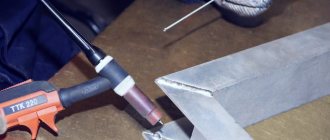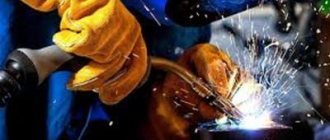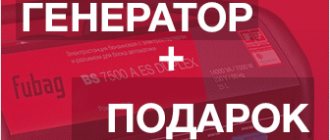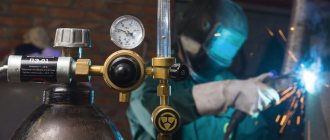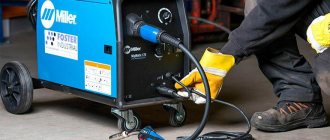Home page » stainless steel welding wire
This section discusses stainless steel welding wire.
For blacksmiths, forges, industries and individuals (homemade workers, self-taught people and enthusiasts).
See below for useful information to help you choose.
Choose brands from the list below the article.
Stainless steel wire DEKA ER308LSi 1.6 mm, 15 kg. Photo by DEKA
Stainless steel welding wire is placed in a separate category due to the presence of an important property - maintaining the anti-corrosion properties of the weld.
Scope, purpose
Stainless steel has become widespread both in everyday life and in production. The use of this steel in the chemical, oil and food industries ensures the operability of the enterprises of these industries. The creation of new and repair of old parts is carried out using welding.
Stainless steel as a consumable material is used in automatic or semi-automatic welding technology. It can be continuous when protected in a gas atmosphere of carbon dioxide, argon and their mixture. Without gas protection, flux-cored wire is used, which is a tube filled with a compound, one of the properties of which is to provide protection to the weld.
Stainless steel welding wire Wester STW08100. Photo 220Volt
Used as a surfacing consumable material. The deposited surface is able to protect the main part from corrosion. Used as a blank for electrodes.
Symbols and markings
Marking of solid wire for welding (surfacing) on the domestic market is carried out in accordance with GOST 2246-70. Stainless steel welding wire is designated as any other alloy wire . The only difference in the chemical composition is the increased content of chromium and nickel.
Example: 3 Sv. – 01Х19Н9 – Ш – E – О GOST 2246-70.
- 3 St. - denotes the technology of application (welding) and its standard size 3.0 mm.
- 01Х19Н9 – chemical composition of the material:
- 01 – carbon (no more than 0.03%);
- X19 – chromium content about 19%;
- H9 – nickel content about 9%.
The chemical composition designation may end with the letter A or double AA. The content of harmful impurities of phosphorus and sulfur is specified here: A - standard, AA - reduced.
- Ш – wire is made using electroslag remelting technology.
- E-wire is used to prepare electrodes.
- O – the surface of stainless wire can be coated with copper. This wire is used for particularly critical connections where arc stability is required.
Stainless steel wire MIG ER-308LSi (1 kg; 0.8 mm) Cedar. Photo VseInstruments.ru
Marking of flux-cored wire used for welding stainless steels is carried out in accordance with GOST 26271-84.
In the international format, they use markings according to AWS (American Welding Society) standards.
Properties and weldability of stainless steel
Steels classified as stainless steels are difficult to weld materials, which is explained by a number of their physical and chemical characteristics. When you decide to cook stainless steel with a semi-automatic machine, you must take into account a number of important parameters. Only in this case can you count on the resulting welded joint being of the required quality and reliability.
Compared to steels of other categories, stainless steel has a fairly low (on average two times) thermal conductivity. Because of this, heat is removed from the welding zone very poorly, as a result of which the metal is subjected to significant overheating, which negatively affects its corrosion resistance. To avoid such negative consequences, welding of stainless steel using a semi-automatic machine is performed at a reduced current (by 15–20%), and the parts to be joined are subjected to additional cooling.
Approximate modes of semi-automatic welding in a shielding gas environment
With significant heating (over 500°), carbide compounds are formed at the boundaries of the crystal lattice of stainless metal, which cause a phenomenon such as intergranular corrosion. As a result, delamination of the internal structure of the metal occurs and corrosion processes develop. To avoid this, they resort to more intensive cooling of the products being joined, for which ordinary water can be used.
It is also difficult to cook stainless steel (including in a protective gas environment) because it has a tendency to thermal expansion. Significant expansion of the joined products that occurs during semi-automatic welding leads to the formation of cracks both in the weld and in the base metal. Meanwhile, this phenomenon can be avoided if a wider gap is left between the parts being welded.
A high-quality stainless steel weld may be slightly grayish, but not dark
Stainless steel, due to the characteristics of its chemical composition, has a fairly high electrical resistance, which causes significant heating of the electrodes used for semi-automatic welding. In this regard, for welding stainless steel, electrodes made of wire with a certain chemical composition are used, and the length of the rods, if they contain chromium and nickel, should not exceed 350 mm.
Kinds
The main technological process where stainless steel wire is used is semi-automatic in an atmosphere of protective gases. To improve process parameters, it can be coated with copper, i.e. be copper-plated (! not to be confused with copper wire). It is used as an additional material in argon arc welding with a non-consumable electrode. Using a gas burner, it is applied to the surface in the form of surfacing.
Useful video
Sequence of work progress
Stainless steel welding can be carried out in three main ways:
- Using a short arc - semi-automatic gas welding, especially suitable for working with thin workpieces;
- with jet transfer - cored wire is used;
- The pulse method is the most accurate and efficient, when the wire is fed into the welding zone by pulses in the form of small drops.
Before cooking stainless steel semi-automatically in carbon dioxide, you need to take into account the general provisions:
- Set reverse polarity - turn on the burner in the positive terminal, and the workpiece in the negative terminal;
- the current should be approximately 20% lower than for conventional welding;
- departure, i.e. distance from tip to tip of wire, no more than 12mm;
- To remove water vapor, the gas passes through a dryer located before or after the reducer.
- fill the device with a coil of wire. Using the broaching mechanism, its tension is adjusted.
Characteristics
When welding stainless steels, it is important to use a welding wire that contains the same components as the base metal . This is the main condition for obtaining a high-quality seam. Chemical composition is the main indicator.
The wire manufacturing technology provides high physical and mechanical properties . They are not inferior to the same characteristics as the base metal.
When using stainless wire as surfacing, it is important to know the deposition rate. With its help, you can calculate the required amount of consumables and select the optimal current value.
Is it possible to weld ferrous metal with stainless steel?
If we talk about production, the technology of welding stainless steel with ferrous metal, then it is initially incorrect due to the difference in materials, their properties, and technical characteristics. However, the connection can be made.
Since enterprises require compliance with GOSTs, this method of joining metals is in demand in small workshops. But to obtain a good connection, you need to know the chemical composition of the components being welded and have practical experience working with them.
Requirements
Stainless steel welding wire must meet all the requirements of GOST 2246-70. When welding, the chemical composition must match the composition of the materials being joined. The melting temperature of the welding wire is lower than or equal to the temperature of the workpieces being welded.
Stainless steel welding wire QUATTRO ELEMENTI 770-407. Photo 220Volt
Features of welding dissimilar steels
Ferrous metal and stainless steel have different chemical compositions and physical properties. The process of welding parts made of dissimilar materials is associated with the following difficulties:
- The weld seam is the weakest point of a metal structure. This is due to the difference in linear expansion coefficients. After solidification of the melt, internal stress remains, reducing the resistance of the joint to loads.
- The joint melts unevenly, which is due to the difference in thermal conductivity. This negatively affects the strength of the weld.
- Carbon atoms migrate, worsening the anti-corrosion properties of the metal. The seam quickly becomes rusty and destroyed.
Distinctive features, advantages and disadvantages
The peculiarity of stainless steel welding wire is that it cannot be replaced by any other with the same corrosion resistance properties.
The main advantage is the possibility of semi-automatic welding . This achieves welding performance. Welding is performed in a gas protective atmosphere.
The disadvantage is the mandatory presence of a gas cylinder . The inability to guarantee protection of the weld in the open air is a disadvantage of this welding method.
These disadvantages are overcome by the possibility of using stainless steel cored wire. Here welding can be done without gas, there are no restrictions for welding outdoors. However, the formation of slag and the high cost of wire make gas protection a more acceptable option. Moreover, the quality of the seam is higher.
Basic rules for performing work
Regardless of the welding method and the type of shielding gas used, you should adhere to the basic rules and recommendations:
- Work is performed when connecting with reverse polarity.
- The burner must be held at the optimal angle relative to the surface to ensure metal penetration to the full depth and optimal width.
- The wire feed is adjusted so that the overhang does not exceed 12 mm.
- For operation, gas consumption is adjusted in the range from 6 to 12 cubic meters per hour.
- The shielding gas is dried before being supplied to the welding zone. To do this, simply pass it through a desiccant based on copper sulfate. Before use, the vitriol is calcined at a temperature of about 200 degrees Celsius for 20 minutes.
- It is advisable to protect the surface adjacent to the joint from hot splashes. For this purpose, it should be treated with chalk dissolved in water.
- You should not start stitching from the edge of the joint. It’s better to step back about 5 mm from the edge, and then go back and weld the missing section. In this simple way it is possible to prevent the formation of hydrogen cracks.
- The electrode must be guided strictly along the seam. You should not make lateral movements. If this rule is violated, the molten metal will end up outside the protective environment.
Recommendations for use
Stainless steel wire 308LSi (0.8 mm; cassette 15 kg) BARS. Photo VseInstruments.ru
- Clean the welded edges with a wire brush or grinder. Degrease.
- Set the required gap according to the regulatory documentation.
- Grab it.
- Select shielding gas . Pure carbon dioxide produces a lot of spatter. It is better to use it in a mixture with argon.
- When welding with shielding gas, it is recommended to keep the arc as short as possible. This will prevent the formation of so-called hot cracks. The shape of the seam with such an arc does not contribute to their occurrence.
- The melting point of stainless steel is quite high (about 1800°C), therefore an increased welding current is required . Under such conditions, there is a high probability of burning through the material, especially thin sheets. The use of the pulse welding method makes it possible to control this process.
Semi-automatic welding of stainless steel parts
Welding stainless metals requires a special approach to the cleanliness of the edges being joined and their preparation for work. When working with thick metal, it is necessary to remove the edges at an angle from 45° to 60°, and clean the joints with an angle grinder. In addition, using solvents, it is necessary to degrease the welding site, and fasten the parts with a gap of 1.5 mm to ensure the most complete penetration throughout the entire thickness of the metal. Then it is necessary to adjust the supply of inert gas or gas mixture taking into account the thickness of the workpieces.
Preliminary settings for a semi-automatic machine are made based on the following proportions, namely:
- when the metal thickness is less than 1 mm, use 0.6−0.8 mm wire with a feed speed of 150 m/hour and a gas flow rate of 6−7 l/min;
- metal 1.5 mm thick is welded with wire 0.8-1 mm in diameter at a speed of 150 to 200 m/h and a protective gas supply of 6-8 l/min;
- 2 mm stainless steel is connected with products with a diameter of 1–1.2 mm, speed 200–250 m/h, gas flow from 7 to 9 l/min;
- for 3 mm stainless steel, use 1.2-1.4 mm wire, at a speed of 250-300 m/h and with a gas supply from 9 to 11 l/min;
- for parts more than 4 mm thick, a wire of 1.4–1.6 mm is required when moving above 300 m/h, and gas is supplied at a flow rate of more than 11 l/min.
The arc voltage depends on its length and is set from 19 V to 30 V with experimental selection, as well as the electrode extension. On a number of high-quality MIG/MAG inverters, there is an inductance adjustment mode, which determines the depth of penetration and the width of the weld seam.
Preliminary settings are advisory in nature and are selected individually depending on the composition of the metal, type of wire, gas mixture and welding speed.
After selecting the wire for semi-automatic welding in relation to the workpiece material, it is necessary to place the drum on the shaft and insert the wire into the feeder. Then adjust the moving speed, which is usually related to the welding current, the higher the speed, the higher the supplied value. The last stage of preparation for work is adjusting the parameters of the gas mixture, adjusting the voltage and inductance. It is important to follow the instructions for using the semi-automatic inverter and observe safety regulations when welding.
Manufacturers
Quite a lot of enterprises that produce consumables specialize in the production of stainless steel welding wire, some of them.
ESAB is a Swedish company whose activities are based on innovative solutions in all areas of welding technology. Over the 110 years of its activity, it has become a world leader in the welding industry, producing not only stainless, but also polished, copper-plated, aluminum and other types of wire.
Stainless steel welding wire ESAB OK Autrod 316LSi, 0.8mm., 5.0kg. Photo Welding Technologies
OLIVER has been on the welding technology market since 1993. The company has kept pace with evolving trends and continues to strive to look into the future.
LINCOLN ELECTRIC is an American company founded in 1895, which released the world's first single-user welding machine in 1911. Has its own separate enterprise for the production of welding wires.
DEKA is a Chinese manufacturer offering a wide selection of stainless steel wires at affordable prices.
Features of using a semi-automatic machine
The use of a semi-automatic device has its own characteristics.
There are 3 options for performing welding work with such a unit:
- using pulse technology;
- using a short arc;
- with jet transfer.
Pulse welding creates a protective environment. For this, argon mixed with carbon dioxide is used.
The short arc technique is used to weld thin sheets of steel. In this case, the risks of burning the material are minimal.
The string transfer technique is intended for welding thick structural elements. It is used in production. To connect the workpieces, special heads and flux-cored wire are used.
ESAB welding wire
Consumable material in the form of welding wire is widely used in various welding technologies. The presence of this product in the range of manufacturers with influence in the welding materials market is a prerequisite. ESAB, as a world leader, is distinguished by its production of wide-purpose wires, covering all possible areas of its application. Areas of application ESAB welding wire is in demand in oil and gas, shipbuilding, mechanical engineering, chemical and other industries. IN…
Welding wire: consumption, threading, feeding
To perform one-time welding work at home, you need to decide on the amount of consumables that you will need to purchase in the store. In industrial conditions, the amount of welding wire consumed will affect the final price of the product produced and, ultimately, customer demand. Features of wire Wire consumption is influenced by many factors, including the human factor in the context of whether the welder has the required qualifications. However, the most objective is the meaning...
Welding wire manufacturers
Wire is a consumable material that is in high demand today. Therefore, many companies, in Russia and abroad, specialize in the production of welding wire. The most significant manufacturers, as well as the features of their products, popular brands of consumables and other information useful for craftsmen are presented in this review. List of countries and manufacturing plants The company has modern equipment at its disposal, qualified employees of the enterprises use the latest…
Welding wire: brands, markings, types
Welding work is carried out with any materials - it can be cast iron, steel or non-ferrous metals. Technologies make it possible to perform these works on productive automatic and semi-automatic machines. The functionality of this equipment is ensured by consumables in the form of wire. Application The main purpose is to use consumables on semi-automatic machines in an atmosphere of protective gas. In cases where self-shielding wire is used, welding is performed without gas. The wire is used as surfacing…
How to cook stainless steel semi-automatically in a carbon dioxide environment: video, tips
Welding stainless steel with a semi-automatic machine can be quite difficult not only for a beginner, but also for an experienced specialist. Such difficulties are primarily associated with the characteristics of the metal itself, for high-quality welding of which it is necessary to correctly select the operating welding modes and the appropriate consumables.
Semi-automatic welding machine for metal welding in a protective gas environment
Welding wire deck
The DEKA trademark is represented on the market with products related to welding technology. In addition to welding equipment and welder protective equipment, a large range of consumables is sold - welding wire, which has found application in many areas of business where there is a need to create strong connections: in the manufacture of various types of industrial, medical and some other types of equipment of complex design. Also in the shipbuilding industry and mechanical engineering. What…


